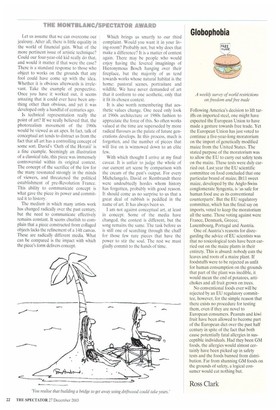Let us assume that we can overcome our jealousy. After
all, there is little equality in the world of financial gain. What of the more pertinent issue of artistic technique? Could our four-year-old kid really do that, and would it matter if that were the case? There is a standard response to those who object to works on the grounds that any fool could have come up with the idea. Whether it is obvious afterwards is irrelevant. Take the example of perspective. Once you have it worked out, it seems amazing that it could ever have been anything other than obvious, and yet it was developed only a handful of centuries ago.
Is technical representation really the point of art? If we really believed that, the photorealism movement of the 1960s would be viewed as an apex. In fact, talk of conceptual art tends to distract us from the fact that all art has a controlling concept of some sort. David's 'Oath of the Horatii' is a fine example. Seemingly an illustration of a classical tale, this piece was immensely controversial within its original context. The concept of the sacrifice of the few for the many resonated strongly in the minds of viewers, and threatened the political establishment of pre-Revolution France. This ability to communicate concept is what gave the piece its power and committed it to history.
The medium in which many artists work has changed radically over the past century, but the need to communicate effectively remains constant. It seems churlish to complain that a piece constructed from collaged objects lacks the refinement of a 14ft canvas. These are radically different media. What can be compared is the impact with which the piece's form delivers concept.
Which brings us smartly to our third complaint. Would you want it in your living-room? Probably not, but why does that make a difference? It is a matter of context again. There may be people who would enjoy having the fevered imaginings of Hieronymous Bosch hanging over their fireplace, but the majority of us tend towards works whose natural habitat is the home: pastoral scenes, portraiture and wildlife. We have never demanded of art that it conform to one aesthetic, only that it fit its chosen context.
It is also worth remembering that aesthetic values change. One need only look at 1960s architecture or 1980s fashion to appreciate the force of this. So often works valued at the time are superseded by more radical flavours as the palate of future generations develops. In this process, much is forgotten, and the number of pieces that will live on is winnowed down to an elite few.
With which thought I arrive at my final caveat. It is unfair to judge the whole of our current art scene by comparison with the cream of the past's output. For every Michelangelo, David or Rembrandt there were undoubtedly hordes whom history has forgotten, probably with good reason. It should come as no surprise to us that a great deal of rubbish is peddled in the name of art. It has always been so.
I am not against conceptual art, at least in concept. Some of the media have changed, the context is different, but the song remains the same. The task before us is still one of searching through the chaff for those few rare pieces that have the power to stir the soul. The rest we must gladly commit to the hands of time.


























































 Previous page
Previous page